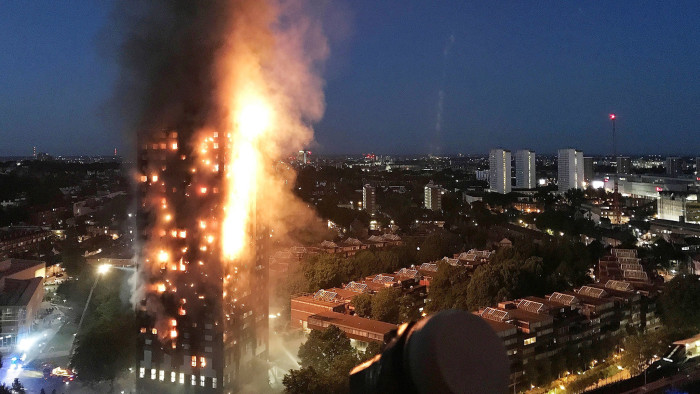Grenfell Tower blaze shows we tinker with rules at our peril


Roula Khalaf, Editor of the FT, selects her favourite stories in this weekly newsletter.
When Grenfell Tower, the 24-storey block in west London engulfed by fire on Wednesday, was designed in the 1960s, the council would have been given an incentive to build it as a high rise. Government subsidies encouraged the building of towers (of six storeys or more) for social housing. The tower was seen as the future, the antithesis of the earthbound slums. It was the visual symbol of the welfare state, evidence that something was being done and that society was being remade.
Today’s London towers are symbols of the exact opposite. The high rise has become a cipher for property as investment asset and the polarised city.
From its beginnings in Chicago at the end of the 19th century, the high rise has proved remarkably resilient. But, as the terrible tragedy at Grenfell Tower showed, it also carries within it the germ of disaster. As the French thinker Paul Virilio suggested, the invention of the train was also the invention of the train crash. The flames shooting up the façade of Grenfell Tower present an unforgettable image of the contemporary urban nightmare.
Yet in London these disasters seem to affect only social housing towers: the collapse of Ronan Point in 1968, the fires at Lakanal House in 2009, Shepherds Court last year and Grenfell House this week. Clearly cost has something to do with it, but the irony is that it seems this latest tragedy was exacerbated by spending. The block had just undergone an £8.7m refit — but to what end? The cladding that is now under such scrutiny was fitted partly to improve insulation but also to encase the concrete façade in a smooth simulacrum of the commercial private towers rising across the city. The dangers of flammable cladding materials and the cavities behind them in which fire can spread unseen have been known for years. These cheap and nasty, and perhaps even lethal, panels represent an attempt to screen the original nature of the architecture of modernist social housing.
Fashion is shifting. The concrete towers once derided as slums in the sky have been rediscovered. Trellick Tower, the concrete high rise completed by architect Erno Goldfinger two years before nearby Grenfell Tower, is now a highly desirable address. The residents of the same architect’s Balfron Tower in east London have been turfed out while their old flats are turned into luxury housing. The uncompromising concrete aesthetic that Kensington and Chelsea borough council was attempting to conceal is now so fashionable it has been commodified as urban authenticity. What they were trying to hide was the image of the high-rise as “sink estate”.
The legacy of well intentioned architectural meddling easily elides into social cleansing — estates in deprived but well-located neighbourhoods somehow fail to find alternative accommodation for the tenants they have “decanted”. But in parallel, there has also been a long and successful political campaign to denigrate regulation.
The building regulations in place when Grenfell Tower was designed demanded generous space standards (which were abandoned by Margaret Thatcher’s government in 1980) and made rigorously codified fire provision for escape and compartmentation. These had been eroded in the rebuilding of Grenfell Tower as more flats were squeezed in to increase accommodation.
Regulation has been denounced as “red tape” and the Conservatives have consistently voted against legislation to regulate landlords’ obligations better. Building regulations for fire prevention and safety have not been reviewed for more than a decade, even though most regulations are re-examined every couple of years to keep pace with changing technology and materials.
The right has gleefully pointed to Brexit as an opportunity for a “bonfire” of red tape. Sparks from a bonfire, however, can sometimes catch.
The writer is the FT’s architecture critic
Comments